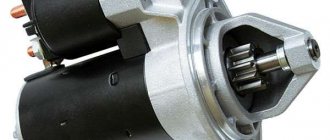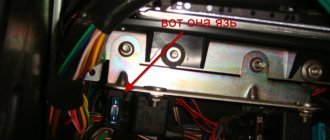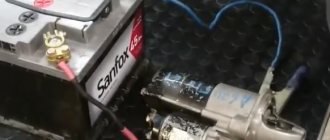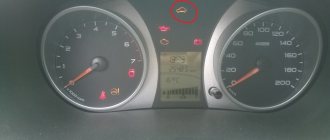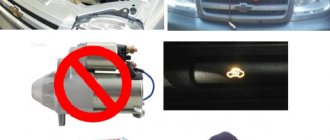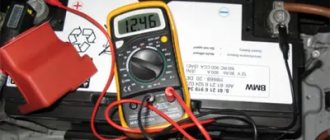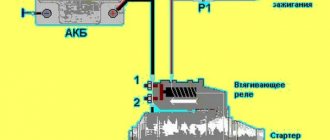The wiring diagram for hatchbacks 2112 is a unique thing in itself. In order for voltage to appear on the solenoid relay, the following parts must be in good working order: the ignition switch, the ECU unit and two more relays - the main and additional ones. Some cars do not have an additional relay, which can be considered good luck. But, if when you turn the key on a VAZ-2112 the starter does not turn, then the fault must be looked for in the wiring. A broken immobilizer code can also cause problems. The last malfunction can be cured by replacing the ECU or disabling the immobilizer. Well, let's look at something simpler.
The reader will be surprised, but there will be more than one scheme here. The most difficult option is shown below.
Scheme with an additional starter relay Please note: relay K2 is not at all “unloading”. A significant current flows through the lock contacts, and relay K2 can be called “blocking”: when it does not work, the starter does not turn. Why is this necessary, think for yourself.
If an attacker closes the contacts in the lock, he will not only be unable to start the engine, but also not use the starter. That is, the hijacker will not drain our battery. The circuit shown above is used with 1.6 liter injection engines. There may be another option - a simpler one.
Circuit without additional relay There is no blocking relay here. The current flows to the solenoid relay from pin 50. A simple version of the circuit is typical for cars from early years of production. Which applies to the entire “Ten” family, including hatchbacks. That is, an interesting combination occurs: the model is VAZ-2112, and the starter will turn even in the absence of all relays and ECUs!
The starter doesn't turn, what happens?
We know that there are two variants of the scheme. If “option 2” is implemented, voltage to the starter is supplied directly from the lock. But the ignition switch in the “Tens” is short-lived, since 30-40 Amperes are transmitted through it (the current of the solenoid relay).
This is true for both the sedan and the 2112 hatchback, and the starter may not turn only because the lock is broken. Draw your conclusions!
All of the above also applies to “diagram 1” - look at it carefully. The main relay is located in the extension block. It is located under the stove on the right.
An additional relay is located in the main unit (see photo). However, it may be missing.
If “option 2” is implemented, check only the lock. And if there is an additional relay, it is not recommended to install a jumper instead. Marked in the photo:
- Additional relay (white arrow);
- Main relay (element “6”).
Failure of spark plugs
The first thing you should think about after checking the presence of power and the ignition switch is the integrity of the spark plugs. Because even if there is a spark, they may not work correctly. Checking them is quite simple:
- the spark plug is unscrewed from its socket using a special key;
- one of the candlesticks is put on it;
- Next you need to “turn” the starter.
The spark between the central and side electrodes must be blue. If it is red or completely absent, the spark plug must be replaced. This part is a consumable item. According to the regulations, regardless of the recommendations of the manufacturer of the spark plugs themselves, they must be replaced every 10 thousand km.
Replacing the VAZ 2112 starter relay if necessary
Final check before replacing the starter
We turn the key to position II, and nothing happens... In this case, open the hood and remove the air filter by unscrewing the screw on the body and loosening the clamp on the pipe. The starter is located under the filter housing. In the photo we see the following: someone disconnected the solenoid relay cord.
What we found under the filter, we check with a needle probe that when you turn the key, “+12” appears. Then, after checking, we wrap the cord with electrical tape.
Sometimes voltage seems to be supplied to the starter, but the solenoid relay is activated “every time”. Well, try cleaning the terminal - both in the connector and on the starter itself. Consider the situation:
- The copper is polished to a shine;
- The wire (see photo) is supplied with “plus”;
- The starter doesn't even click.
The first thing you need to check is the battery contacts. We remove the terminals (key “10”) and look at what is under them. There is no point in measuring the voltage with a probe - it will show “12 Volts”.
Solenoid relay current – 40 Amperes. The presence of a resistance of 0.1 Ohm results in a voltage drop of 4 Volts. So consider... And the starter motor consumes 200 Amperes during operation.
Scheme, theory and practice
Let's see what the wiring diagram of any electric starter looks like. Contact B is constantly supplied with voltage.
Starter and its external circuits
In the diagram we see three “positive” contacts and one negative (8), which is always connected to the body. What needs to be closed:
- Before closing the starter, locate the S terminal. It is often made in the form of a petal;
- How to distinguish contacts B and M: the first will have a potential of “+12”;
- You need to close contact B with terminal S. This is done briefly and after turning on the “neutral”;
- Contacts M and B cannot be closed.
We move from theory to practice. On a VAZ-2114 car everything looks simple.
Solenoid relay VAZ-2114
Terminal B here is covered with a rubber band, and petal S is in contact with the terminal in plastic. The plastic plug is removed before “shorting”.
Closing the starter contact with a screwdriver
Make sure that the metal of the screwdriver does not touch the relay body when closing. Otherwise, we will simply close the “+” contact to “ground” (dangerous). All work is carried out with the ignition on.
- B – Bold, “thick” wire;
- M – Motor (electric motor);
- S – Start.
Why doesn't the starter turn over?
Depending on what caused the starter to fail, it is necessary to take the next steps - repair or replace the unit. In addition, in some cases, you do not need to repair the starting device itself, but manipulate other components. In most cases, you can get by with repairs, but experienced car enthusiasts recommend immediately replacing the unit so that there are no more problems with it.
- Most VAZ-2110s do not have a standard injector, but many car enthusiasts install this unit themselves. It helps reduce fuel consumption, helps start the engine in cold weather without warming up and increases power. The injector fails, and along with it the starter, due to low-quality fuel. Another reason may be failure to follow the connection diagram, but then you will discover a malfunction immediately after installing the injector. Otherwise, you need to flush the injector to remove any suspended matter that is carried into it by the fuel.
- If the car starts, but after a short stop the engine cannot be restarted, then the problem lies in the overrunning clutch. At the moment of failure, you may hear clicking sounds from under the hood and notice that the car radio begins to turn on by itself. In this case, you need to cool the power unit before restarting or not make short stops. You will also need to replace the overrunning clutch with its geared counterpart. Be sure to check the conductors that come from this node. Sometimes, to restore the functionality of the coupling, it is enough to replace the wires that visually look damaged.
- The retractor part of the starter especially often fails. When such a breakdown occurs, the dashboard lights first light up and then go out. Before replacing the solenoid relay, you must close the starter and turn off the alarm. If the listed components are in working order, then you will simply have to replace the relay.
- Clicking sounds in the starter and failure to start the engine are often caused by damaged contacts. In this case, first inspect the battery, clean the terminals if oxide appears on them. Sometimes on a VAZ-2110 it is enough to tap the starter relay to get rid of the problem. Be sure to take an assistant with you who will start the engine while you tap the relay. If with such a rough approach it was possible to start the engine, then it is worth replacing the relay completely. Repair will be impractical.
- An unexpected engine stop is caused by problems with the immobilizer. You will not be able to start the engine because the protection is triggered. This only happens on injection VAZ-2110s. It is impossible to fix the problem on your own; call a tow truck and go to the nearest service station, where they will be able to restore your car’s functionality.
Where is he located
This question is asked by those who have just become the proud owner of a vehicle. In most cases, people think about its location under the hood when it starts acting up, or by those who like to tinker with the car themselves in the garage.
Regardless of the type of engine and its location under the hood, manual or automatic transmission, the starter is located in close proximity to the box, partially bolted to it.
Remember, when we looked at the principle of operation of the clutch, such a part as the “flywheel” was mentioned. It is connected to the crankshaft of the engine, and through it and the clutch, torque is transmitted from the engine to the gearbox. It is shaped like a large gear and is connected to the starter with its teeth. Therefore, you can always find it near the gearbox, because through the Bendix mechanism (we’ll talk about this “beast” later) rotation is transmitted to the flywheel gear, and from it to the engine crankshaft.
Before talking about the principles of operation, let's look at what it consists of.
How to accurately determine that the starter needs to be replaced
It is not always worth wasting your time to fix a faulty starting device with minor or partial repairs. Large-scale troubleshooting is often impractical at this site. Before removing, let alone disassembling, the starter, you need to remember three signs when you should rush to purchase new spare parts:
- When you turn the key in the ignition, you hear a grinding noise in the engine compartment area. This directly indicates a malfunction of the bendix (overrunning clutch) or flywheel. It is these parts that need to be replaced.
- Clicking noises when the starter fails to operate means the relay is faulty.
- A strained engine start is evidence of failure of the starter brushes.
The most common cause of clicking sounds in the starter is considered to be a failure of the retractor. The relay is not that expensive, and you can also try to fix it yourself. This will require a lot of effort, but will save you from replacing the unit. Just remember that this is a temporary measure, the restored relay will not be enough for a long time, and in some cases the bulkhead will not help.
Under the relay body you can find the armature, coil, rod and contacts. Most often, oxide appears on parts of this device, which is time to try to clean. However, it is worth remembering that this measure is sometimes ineffective. Therefore, it is best to immediately buy a new spare part.
Communication connections
Worn wires and oxidation of contacts can also cause the starter to not work correctly. Long-term operation contributes to wear of the wires, and moisture ingress leads to oxidation of the connections.
Periodically replacing the wiring of the appropriate cross-section and regularly checking the contacts and cleaning them will help avoid problems with starting the engine.
These are the most common reasons why the starter clicks but does not turn. And even if you have a VVAZ 2112, or a Nexia or another brand, or a different design of the device, you will have the same problems with a discharged battery, worn parts and wiring.
Regular maintenance with diagnostics will help to identify problems in a timely manner and avoid unpleasant surprises.
How much does it cost to replace a starter?
Beginning car enthusiasts often have questions after visiting a parts store. Most often they are interested in why relays have very different prices. First of all, it is worth remembering that spare parts for the VAZ-2110 are manufactured not only by domestic factories, so you can find relays under brands such as BOSCH or Tomahawk. They are more expensive than those produced in Russia. At the same time, domestic ones have a better price-quality ratio. Brands such as VIS or Torgmash will cost you much less.
If you prefer to install original components from AvtoVAZ (often in stores they are labeled “made in Tolyatti”), then the relay will cost you about 1,000 rubles, and the entire starter – 5,000. Domestic manufacturers of spare parts can offer you more budget options. The price may be half as low, but the quality is not always worthy. Imported analogues, on the contrary, are twice as expensive, so a starter from BOSCH can be found for 10 thousand rubles, a relay will cost about 2,000.
Rotor winding faults
The simplest way to check the serviceability of the starter is to apply current from the battery directly to the power contact, bypassing the traction relay. This will allow you to find out how the electric motor behaves and whether it shows any signs of life.
But before checking the functionality of the battery starter, try to use only thick copper stranded wires with good insulation.
If the rotor does not rotate, you will have to check it too. The following malfunctions most often occur:
The easiest way to make repairs is to install a new rotor. Rewinding the winding is problematic, since it is difficult to find a suitable wire.
